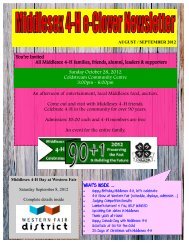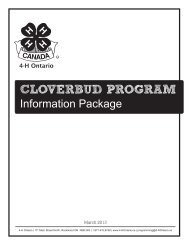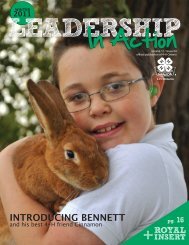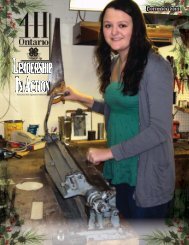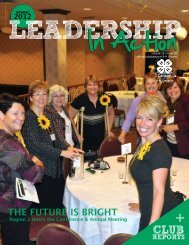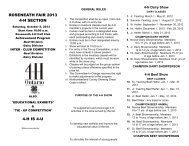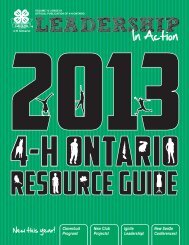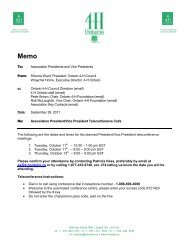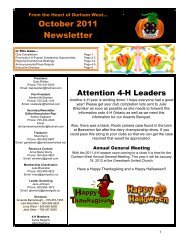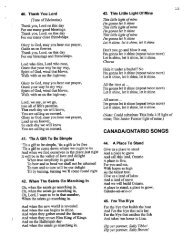Youth Leader Manual - 4-H Ontario
Youth Leader Manual - 4-H Ontario
Youth Leader Manual - 4-H Ontario
- No tags were found...
Create successful ePaper yourself
Turn your PDF publications into a flip-book with our unique Google optimized e-Paper software.
4-H ONTARIO PROJECTwww.4-hontario.ca<strong>Youth</strong> <strong>Leader</strong> ProjectPROJECT MANUAL
24-H ONTARIO | YOUTH LEADER PROJECTThe 4-H PledgeI pledge my Head to clearer thinking,my Heart to greater loyalty,my Hands to larger service andmy Health to better livingfor my club, my community and my country.The 4-H MottoLearn To Do By Doing4-H GraceWe thank Thee Lord for blessings greatOn this our own fair landTeach us to serve Thee joyfullyWith Head, Heart, Health and Hands4-H <strong>Ontario</strong> Provincial Office111 Main StreetRockwood, ON N0B 2K0toll free: 1-877-410-6748telephone: 519-856-0992fax: 519-856-0515email: inquiries@4-hontario.caweb: 4-H<strong>Ontario</strong>.caProject Resource Information:Originally Written by: Arlene RossRevised by: Elizabeth Johnston, 4-H <strong>Ontario</strong>Edited by: Victoria Kyle, 4-H Member, Brant, Alex Mitchell, 4-H Member, Renfrew,Samantha Klaver, 4-H Member, Perth, Julia Romagnolia, 4-H Member, Niagara,Carol Morton, 4-H Member, Durham East, Jennifer Pollock, 4-H Member, Wellington,Tracey Stark, 4-H Member, Perth, Steven Stockdale, 4-H Member, PeterboroughLayout by: Kristen Clancy, Red Pencil DesignDate: March 20134-H <strong>Ontario</strong> grants permission to 4-H Volunteers to photocopy this 4-H project resource for use in their local 4-H program.The development, production and distribution of this 4-H <strong>Ontario</strong> project resource has been supported by proceeds of the4-H <strong>Ontario</strong> Dream Dinner Lottery.
4-H ONTARIO | YOUTH LEADER PROJECT 3Welcome to 4-H <strong>Ontario</strong>’s ‘<strong>Youth</strong> <strong>Leader</strong> Project!’Congratulations on choosing to become a <strong>Youth</strong> <strong>Leader</strong>! This is an excitingexperience and leaders believe you are a valued resource for this project. Youare now a role model to younger 4-H Members.The <strong>Youth</strong> <strong>Leader</strong> Project offers senior 4-H Members an opportunity to developskills through the practice of leadership with the guidance of 4-H <strong>Leader</strong>s. Thisexperience is designed to provide Members with the opportunity to learn aboutthe qualities and abilities needed to be a leader. Members who complete theproject requirements to the satisfaction of the leaders will receive a 4-H <strong>Youth</strong><strong>Leader</strong> credit.ObjectivesThe objectives of the 4-H <strong>Youth</strong> <strong>Leader</strong> Project are to give senior 4-H Membersan opportunity to:1. Put leadership into action at the club level.2. Further develop communication, interpersonal and organizational skills.3. Prepare to take on other leadership roles.4. Work collaboratively with 4-H <strong>Leader</strong>s to set goals, develop meeting material,teach skills and evaluate activities.5. Communicate with 4-H <strong>Leader</strong>s and Members about group expectations,responsibilities and expected outcomes.6. Be a valuable resource to the 4-H program.RequirementsIn order to complete the 4-H <strong>Youth</strong> <strong>Leader</strong> Project the following requirementsmust be met:1. Be at least 15 years old and no more than 21 years old prior to January 1st ofthe current calendar year.2. Participate in a New Volunteer Orientation Training session, a VolunteerSymposium, both offered by 4-H <strong>Ontario</strong> Volunteer Support Coordinators or
44-H ONTARIO | YOUTH LEADER PROJECTparticipate in Provincial <strong>Leader</strong>ship Camp (PLC), Future <strong>Leader</strong>s’ In Action(FLIA) or Ignite <strong>Leader</strong>ship. This training must be renewed every two years.3. Participate in at least 2/3 of your own club meeting time.4. Complete the project requirements to satisfaction of the club leaders.5. Lead a number of club activities at club meetings within a project.6. Complete the Activity Record Sheets in this Project Book. This section hasbeen designed to record your progress. This must be handed in to your Club<strong>Leader</strong>s who will, in turn, hand it in to your local 4-H Association in order foryou to receive completion for this project.7. Take part in an Achievement Program.8. Take a leadership role in the club, county, district or region by completing oneof the following:a. Take an active part in the planning of the Achievement Program andparticipate by chairing, leading activities, introducing or thankingspeakers, etc.b. Take an active part in the planning of an event such as a JudgingCompetition, New Member/Membership Drive Event, Field Trip,Fundraisers (eg. Car Wash) and participate by chairing, gettingsupplies, emceeing, leading activities, thanking volunteers, etc.c. Prepare an exhibit for the Achievement Program, a local fair or eventor an organization’s meeting.d. A project approved by the club leaders. Project should be related toeither the 4-H club or the community.
4-H ONTARIO | YOUTH LEADER PROJECT 5How to Use This <strong>Manual</strong>This Reference is presented in two sections:Section 1 – Information, Tips and Hints for Planning ActivitiesThis section needs to only be printed once and kept as a resource guide.This section provides the background information needed to be able to presentthe Project material in the best possible manner. Information for planningactivities, different styles of presentations and social activities, resources andhints for getting the most out of your experience as a <strong>Youth</strong> <strong>Leader</strong> all appear inthis section.Section 2 – Activity Record SheetsThis section is to be printed and completed for each club a 4-H Memberparticipates in as a <strong>Youth</strong> <strong>Leader</strong>. These record sheets need to be signed by theClub <strong>Leader</strong>s and then submitted to the local Association for the 4-H Member toreceive credit for a <strong>Youth</strong> <strong>Leader</strong> Project.The Activity Record Sheets provide <strong>Youth</strong> <strong>Leader</strong>s with a permanent record oflearning opportunities, activities completed, challenges and accomplishments.As well, this section features a <strong>Youth</strong> <strong>Leader</strong>ship Resume Template to recordaccomplishments not only from this <strong>Youth</strong> <strong>Leader</strong> Project, but from all <strong>Youth</strong><strong>Leader</strong>ship opportunities. This Activity Records Book will be a valuable source offeedback for youth as they go forward with further <strong>Leader</strong>ship opportunities.
6 4-H ONTARIO | YOUTH LEADER PROJECT | INTRODUCTIONIntroductionThe most effective way of learning for a <strong>Youth</strong> <strong>Leader</strong> and 4-H Members is to“LEARN TO DO BY DOING.”To complete a <strong>Youth</strong> <strong>Leader</strong> Project, you are required to lead a number ofactivities. The number of activities you decide to lead will depend on the type ofactivity, preparation involved, nature of your club, decisions you and your leadersmake together and the amount of time you have to spend working with the ClubMembers. Possibilities include:• Four 15 minute presentations of project related material• Six 10 minute activities or presentations• Taking responsibility for some ongoing club activities such as judgingactivities at each meeting, social recreation at each meeting or workingwith the younger Members in the club regularly• A combination of the aboveYour activities can take many forms. Vary your styles and activity choicesthroughout the project. This will give you a chance to try different styles and yourclub Members a chance to learn and participate in different ways.Possible activities include:• Presenting project material using an array of styles such asdemonstration, role play, skit, discussion group, panel question andanswer session. Video/ powerpoint presentation, displays and tours are allexamples of effective ways of presenting material.• A social activity/game – getting acquainted, ice breaker or stretcherexercisesPlanning Guidelines1. GETTING STARTED WITH THE PROJECT• Meet with your club leaders to discuss your involvement as a <strong>Youth</strong><strong>Leader</strong>. Keep in mind that your leaders are busy people so make the
4-H ONTARIO | YOUTH LEADER PROJECT | INTRODUCTION7most of the time you meet with them. As well, phone calls and e-mails areeffective ways of communication.• Share your ideas on how you would like to be involved• Listen to your leader’s ideas on how he/she would like you to be involved• Make a decision about what type of involvement will suit you and your clubleaders and will benefit your Club Members• Communicate regularly with your club leaders so they know what you aredoing and vice versa2. BEFORE EACH MEETING ASK YOURSELF THE FOLLOWINGQUESTIONS:• How will you present your activity?• How much time do you have on the agenda?• When is the optimal spot on the agenda for your activity? (e.g. getting themembers to run around is not the best way to start a meeting as they maynot settle down and focus)• What supplies or equipment will you need?• Does the activity involve all club members?• Do you need to take into account any special needs any of the clubMembers may have? (e.g. Does someone have food allergies? Is there aclub Member who may not be able to physically participate in the activity?)Practice your activity so you are ready to deal with any difficulties you mightencounter and brainstorm variations in the case that the activity does not proceedas initially planned.Talk to your club leaders if you have any questions while planning.
8 4-H ONTARIO | YOUTH LEADER PROJECT | INTRODUCTION3. DURING THE MEETING• Make sure all Members are involved• Stay within the allotted time so the meeting will stay on schedule4. AFTER THE MEETINGUsing the Activity Record Sheets found in this manual, evaluate your activity byasking the following questions:• Was the activity a success?• What do you think you did well?• What changes would you make for next time?• Did Members like or dislike the activity?• Did the members learn the necessary knowledge from the activity?Ask your leaders for their comments about your activity. Use the comments aspositive feedback to help you with your next activity.
10 4-H ONTARIO | YOUTH LEADER PROJECT | SELECTING ACTIVITIES• What are their interests?• How much does your audience already know about the subject?• What has already been covered in your 4-H club and what is to come laterin the club?• What are the talents and abilities of the Members and <strong>Leader</strong>s?4. RESOURCES• Use some of the resources listed on page ##. Don’t be afraid to try newideas and activities with your Members.• You can use <strong>Leader</strong>s, Members, parents or people outside of the club withspecial talents for certain types of presentations.5. FACILITIES OR ENVIRONMENTBefore you decide upon the type of activity, consider the facilities or environmentwhere your event will be held. Ask yourself:• Will your audience be sitting or standing?• Is there room to move around and be active if needed?• Can the activity be conducted safely so nobody is injured?• Can everyone see and hear the speaker?• Can everyone hear who are participating in the activity?• Can discussion be easily held?• Is the equipment you need available? (laptop, projector, blackboard, etc.)
4-H ONTARIO | YOUTH LEADER PROJECT | SELECTING ACTIVITIES116. RETENTIONHow much the Members remember (retain) depends on how they receive thematerial. From the following chart you can see how much more informationmembers will retain if they have a chance to “do and say” rather than just “hear.”METHOD RETENTION EXAMPLESReadingHearingHearingHearing and SeeingSayingSaying and DoingMembers will retain 10%of what they read.Members will retain 20%of what they hear.Members will retain 30%of what they see.Members will retain 50%of what they see andhear.Members will retain 70%of what they personallyexplain.Members will retain90% of what they arepersonally involved insaying and doing.Members’ manual, factsheets, handouts.Lectures, speakers,having someone readinformation out loud.Exhibits, posters,illustrations.Watching videos,demonstrations,powerpoint, tours.Discussion groups,judging, presenting orexpressing ideas.Practice, explore,demonstrate, build.
12 4-H ONTARIO | YOUTH LEADER PROJECT | SELECTING ACTIVITIESDifferent Types of Activitiesto Present Project Information1. HANDS-ON ACTIVITIESHands-on activities allow the members to actually practice the skills they arelearning. This is often the most effective way for members to learn and retaininformation.Examples:• Using a computer• Clipping a beef or dairy animal• Sewing on a button• Using a camera• Making pudding, bread or a cake• Building a campfirePROS CONS HOW-TO-DO• Actively involvesmembers• Members put learnedinformation intopractice right away• Members can askquestions and you canguide them to answers• May require specialfacilities and/orequipment• Information needs tobe learned in small,manageable chunks• Can be difficult with alarge group• DISCUSS whatmembers will do• SHOW them how todo it• LET MEMBERSDO IT!• ENCOURAGE themto ask questions andsucceed
4-H ONTARIO | YOUTH LEADER PROJECT | SELECTING ACTIVITIES132. ROLE-PLAYIn a role-play, three to six members act out a situation in front of the group. Thereis often no script; members make up their parts as they go.Examples:• Chairing an effective meeting• Planning the Achievement Program• Being a wise consumer• Saying no to drugs• Being bullied at school• Planning for a camping tripPROS CONS HOW-TO-DO• Actively involvesmembers• Freedom for membersto think and act likeanother person• Can be a dramaticway to present aproblem for discussion• Allows Members to becreative• Useful for showinghow to and how notto deal with certainsituations• Some people may betoo self-conscious toparticipate as actors• May be less effectivebefore largeraudiences• Needs to be fairly fastpacedto keep interestof Members• Situation must becontrolled to makesure key messagesare being conveyed• DEFINE thesituation clearly• SELECT playersand give them aminute to prepare• STOP once key pointsare demonstrated• DISCUSS key points
14 4-H ONTARIO | YOUTH LEADER PROJECT | SELECTING ACTIVITIES3. SKITA skit is a short rehearsed presentation involving two or more people. Skits canbe used to present information about the 4-H Project or Program to the public, orto review information learned.Examples:• Our experiences at Provincial <strong>Leader</strong>ship Camp• What happens at a 4-H meeting• “Before” and “After” skits to illustrate what members learned in their club• “Right” or “Wrong” skits to present information on how to bake a cake• How to judge a goat, dairy heifer, quilts, cheese, etc.PROS CONS HOW-TO-DO• Actively involvesmembers• Encourages creativity• Brings situations to life• Stimulates discussion• Increases interest• Some may over-actor not take the activityseriously• Takes time to create askit and rehearse it• Humour and actionsneed to be relevant tothe topic• INTRODUCE the skit• SUMMARIZE the keypoints• FOLLOW-UP with adiscussion; such as abuzz session
4-H ONTARIO | YOUTH LEADER PROJECT | SELECTING ACTIVITIES154. BUZZ SESSIONA buzz session can involve every member of a large group in the discussion bydividing the members into smaller groups. Each group will have a chairpersonand someone recording a list of ideas and thoughts (“buzz list”) from the group.Then as a larger group, have everyone look over the lists and invite opinionsfrom the other groups until a point is well covered. Ensure everyone has thechance to explain something.A discussion group is similar, except that the Buzz Session group continues for alonger period of time.Examples:• Evaluating a meeting or event• Developing a list of questions for a guest speaker• Finding out what club members would like to do in the project or for theAchievement ProgramPROS CONS HOW-TO-DO• Gives everyone achance to contribute• Allows shy members achance to speak up ina smaller group• Many headscontributing thoughtscan help the successof the group• Can provide a sourceof fresh ideas• Groups must not betoo large – seven isthe maximum size• Groups need to focuson the overall goal, notthe goals of individuals• Groups may get offtopic• Some individuals maydominate discussion• ORGANIZE intogroups• GIVE clear directionand state the goal• INSTRUCT eachgroup to select achairperson andrecorder• MONITOR time• DISCUSS andRECORD feedbackfrom groups
16 4-H ONTARIO | YOUTH LEADER PROJECT | SELECTING ACTIVITIES5. DEMONSTRATIONA demonstration can be used to teach a skill which cannot be taught by wordsalone. Following it with a hands-on activity is an excellent way to reinforce thelearning.Examples:• How to juggle• Putting an ear tag in a dairy heifer• Laying out a pattern for sewing• Making pastry for a pie• Harnessing a horse• How to square dancePROS CONS HOW-TO-DO• Members see andhear how to perform atask• Questions can beencouraged andanswered• Make sure everyonecan SEE yourmaterials and whatyou are doing andHEAR what you aresaying• Can be difficult with alarge group• PLAN ahead what youwill say and do• ORGANIZE yourmaterials in advance• PRACTICE
4-H ONTARIO | YOUTH LEADER PROJECT | SELECTING ACTIVITIES176. TOURTaking a tour allows members to see things which have been discussed or arerelated to the project.Examples:• Nature walk• Photographer’s studio• Grocery store• Craft supply store• Veterinarian’s office and surgery room• Crop tour of various crops• Farm Machinery dealers’ shopPROS CONS HOW-TO-DO• Can see things unableto be seen elsewhere• Shows membersexamples• Adds interest to theproject• May be dependent onweather, availability ofhosts, flexibility• Time consuming• Special transportationarrangements may beneeded• ARRANGE with thesite managers well inadvance• PREPARE an agenda• BRIEF membersbefore the tour, i.e.purpose, what to lookfor• FOLLOW-UP withdiscussion, questionsor short reports
18 4-H ONTARIO | YOUTH LEADER PROJECT | SELECTING ACTIVITIES7. VIDEOS/POWERPOINT PRESENTATIONSVideos and powerpoint presentations can present information in a creative,informative and entertaining format using a combination of pictures and sound.Sources of videos can include OMAFRA, industry organizations and YouTube.Depending on the topic, powerpoint presentations can be created by a <strong>Youth</strong><strong>Leader</strong> using a variety of pictures, graphs, charts, graphics, etc. Talk to your 4-H<strong>Leader</strong>s before presenting this material to make sure it’s appropriate for the ageof the Members in the club and that it fits well with the meeting content.PROS CONS HOW-TO-DO• Allows members tosee items which youmay not have available• Works well for visuallearners• Can lend another pointof view or informationto a subject• Needs to previewedto ensure it is current,suitable for the agegroup (terminologyand length) and coversthe desired information• Requires equipment• SELECT andPREVIEW• INTRODUCE toexplain the purposeand points to note• SHOW in acomfortable, ventilatedarea• FOLLOW-UP with adiscussion session toreview key points
4-H ONTARIO | YOUTH LEADER PROJECT | SELECTING ACTIVITIES198. LECTUREA lecture is a prepared talk on a subject. An illustrated talk is a lecture in whichvisual aids are used.Examples:• Talk on travel or personal experience• My experiences at Provincial <strong>Leader</strong>ship Camp• Why I want to be a dairy farmer• Humorous talk to entertain guests at a banquet• The benefits of being a 4-H MemberPROS CONS HOW-TO-DO• Suitable for large orsmall audiences• Easy to organize• Can present new ideasand information• Difficult to hold theinterest of members,especially young ones• Need to follow with adiscussion exercise somembers can take part• Limit the length to suitthe audience• Ensure visual aidsand interesting pointsare used to keepsMembers’ attention.• PLAN well in advance• ORGANIZE your talkwith an introduction,body and conclusion• INTRODUCE speakerto the audience• THANK speaker (askanother member to dothis)
20 4-H ONTARIO | YOUTH LEADER PROJECT | SELECTING ACTIVITIESSocial ActivitiesFor ideas about social activities and how they can be used in your club, consultthe 4-H <strong>Ontario</strong> Social Recreation Project, available in the Resources section(listed under Sports, Drama and Dance) on the 4-H <strong>Ontario</strong> website, as wellas the document titled Group Games and Social Recreation, available in theAdditional Resources section of the 4-H <strong>Ontario</strong> website; 4-hontario.ca You willneed your username and password to access these resources.1. GAMESWe are most familiar with games as they are used in social recreation, but gamescan also be a very effective teaching resource.Games can be used to:• Introduce new project material• Encourage members to share their ideas• Review project material• Make material and meetings more interesting and fun• Increase the involvement of members• Promote cooperation• Find out what members have learned (game show format is popular)2. GET ACQUAINTEDThroughout your project, everyone involved will get to know each other. It isimportant for you to provide opportunities for members to get acquainted rightfrom the beginning of the project. Examples of Get Acquainted Games caninclude:• Lucky Handshakes – Several pennies are distributed throughout thecrowd. The people with the pennies are told to give them away to the 10thperson they shake hands with. This encourages mass hand shaking.
4-H ONTARIO | YOUTH LEADER PROJECT | SELECTING ACTIVITIES21• Who Can You Find? – Have a worksheet prepared ahead of time witha list of attributes, interests, etc. in people that each Member must find.Examples include:o Someone who drank milk todayo Someone who has 4 brotherso Someone who likes to go swimming• Name Numbers – have everyone count the number of letters in theirname. Then have Members find someone in the group with the samenumber of letters in their name. Names can be shortened if this helps tofind someone easier (eg. Christopher could also use Chris). This workswell if the group needs to be divided into pairs for an activity.3. ICE-BREAKERSMembers may find the beginning of meetings awkward, especially if parentsor guests are present. You can make this easier by leading a short ice-breakerexercise which will help to relax everyone. Ice-Breaker activities can include:• Two Truths and A Lie - Give members two minutes to write down twothings that are true about themselves, and one thing that is a lie. Then,members, one by one (or two groups if the club is very large) shouldintroduce themselves and state their three ‘facts’. The rest of the clubmembers should try to guess which statement is a lie and which are thetruths.• Who Am I? – Pin the name of someone famous on the back ofeach person. Have them ask the others in the group questions aboutthemselves in order for them to be able to gather clues as to who they are.Once they have figured out who they are, have them sit down.• Snowball Fight – Have each person write down 3 things aboutthemselves (without stating their name) and them crumple up the paperinto a “snowball.” Have everyone stand in a circle and at the word go,everyone can start throwing their snowballs, being careful not to throwthem at anyone’s face. When the leader announces stop, everyone is topick up a snowball and figure out who it belongs to.
22 4-H ONTARIO | YOUTH LEADER PROJECT | SELECTING ACTIVITIES4. STRETCHERS/ENERGIZERSStretchers/energizers are short activities which you can use to give membersa break in the middle of a long presentation, tour or meeting. These could beanything from actual stretch breaks, to short demonstrations, to moving to adifferent location in the room. It’s important to remember that youth often haveshort attention spans. Stretchers give them a chance to move around, relievetension and start all over again. Try some of the examples of Stretchers forstarters:• Stand A Minute – Ask the group to stand up, and after they think a minutehas elapsed, to sit down. See who the closest is to 60 seconds.• Count Three – Tell the group “When I count to three, everyone stand.”(Count, but count unevenly so that they can’t do it together).• Pencil in Belly Button – Take your imaginary pencil and stick it in yourbelly button with the point facing outward. Now write the numbers from 1to 10. Next write your first name. Finally, write your first and last name asfast as you can and then sit down.
4-H ONTARIO | YOUTH LEADER PROJECT | SOURCES OF INFO & IDEAS23Sources of Information & IdeasThere are many sources of information and ideas which can be helpful to you asa 4-H <strong>Youth</strong> <strong>Leader</strong>. Here are some of them:4-H RESOURCESThe following can be found in the Additional Resources section of the 4-H <strong>Ontario</strong>website: 4-hontario.ca• 4-H Fun Pack• 4-H Song Book• 4-H <strong>Youth</strong> <strong>Leader</strong> <strong>Manual</strong> (this manual)• Group Games and Social Recreation• Judging Toolkit• Quality Equation Club Pack• Step Into Our WorldADDITIONAL 4-H RESOURCES• 4-H <strong>Ontario</strong> Social Recreation Project is available in the ResourcesSection (under Sports, Drama and Dance) on the 4-H <strong>Ontario</strong> website.• 4-H Volunteers Handbook. You will receive this when you attend the NewVolunteer Orientation session in your area.LEADERSHIP FACT SHEETSThe following fact sheets are available through the <strong>Ontario</strong> Ministry ofAgriculture, Food and Rural Affairs website at: www.omafra.gov.on.ca/english/rural/facts/factshts.htm or by contacting OMAFRA at: Toll Free:1-877-424-1300; Local: (519) 826-4047; E-mail: ag.info.omafra@ontario.ca• A Quick Reference Guide for Facilitators (Order No. 95-073)• Clear Writing (Order No. 07-049)
24 4-H ONTARIO | YOUTH LEADER PROJECT | SOURCES OF INFO & IDEAS• Communications Planning for Organizations (Order No. 03-033)• Conducting Elections (Order No. 96-015)• Coping With Problem Behavior (Order No. 96-003)• Creating Effective Agendas (Order No. 05-037)• Effective Committees (Order No. 08-061)• Effective Community Decision Making (Order No. 93-043)• How You Can Be An Effective <strong>Leader</strong> (Order No. 94-081)• Managing Issues: A Guide for <strong>Leader</strong>s of Rural Organizations(Order No. 93-019)• Problem Solving (Order No. 94-079)• Procedures For Meetings (Order No. 96-009)• Recruiting Volunteers (Order No. 96-005)• Resolving Conflicts (Order No. 06-067)• So You’ve Been Asked to Speak... (Order No. 87-009)• Successful Meetings (Order No. 05-035)• Tips for Workshop <strong>Leader</strong>s (Order No. 94-007)• Understanding Change (Order No. 91-014)• Volunteers: The Heart of Community Organizations (Order No. 96-017)• Working With Volunteers (Order No. 87-012)ADDITIONAL RESOURCES• You, your imagination and creativity!• 4-H Club <strong>Leader</strong>s, <strong>Youth</strong> <strong>Leader</strong>s and Volunteers• Parents and friends• 4-H <strong>Leader</strong>ship Camp delegates
4-H ONTARIO | YOUTH LEADER PROJECT | SOURCES OF INFO & IDEAS25• Local 4-H Association• Websites for other 4-H organizations in Canada• Volunteers and Members of other youth organizations• Workshops• School• Local Library• InternetAdditional References and Resources4-H Canada 4-h-canada.caMichigan State 4-H 4h.msue.msu.edu/Minnesota 4-H 1.extension.umn.edu/youth/mn4-H/University of California 4-H <strong>Youth</strong> Development Program ca4h.org/
26 4-H ONTARIO | YOUTH LEADER PROJECT | SOURCES OF INFO & IDEASHints for <strong>Youth</strong> <strong>Leader</strong>s(From other <strong>Youth</strong> <strong>Leader</strong>s)• Remember the purpose of the 4-Hprogram• Don’t forget to “Learn To Do ByDoing” (you and other Members)• Involve everyone, especially newand shy Members• Make sure you have time availableto meet requirements beforebecoming a <strong>Youth</strong> <strong>Leader</strong>• Be creative; use your imagination!• Be patient• Make things fun and have funyourself!• Don’t show favouritism• Get involved• Be enthusiastic!• Make your presentations andactivities interactive• Remember – you are a role model• Keep a positive attitude• Watch your audience for theirresponses and listen to themessages they are sending• Learn the strengths andweaknesses of your Members andbuild on them• Take the time to prepare• Be organized• Be yourself• Don’t be nervous• Don’t pretend to be an expert• Everyone learns – you, Members,<strong>Leader</strong>s too!• Expect the unexpected• Don’t be hard on yourself• Don’t rely too much on your<strong>Leader</strong>s• Have fun – it’s your time to play too!• If you need help, ask for it• Use your common sense and goodjudgement• Think of each person in terms oftheir interests and maturity• Provide new experiences formembers• Keep on the lookout for new ideas• Go for it!
4-H ONTARIO | YOUTH LEADER PROJECT | GETTING ALONG27Getting Along……With Your MembersMany of your Club Members will be younger than you are. Your success inworking with other Members will depend largely on how well you meet theirneeds. You should, therefore, know something about them and how they act.Every person is an individual, no matter his/her age. Not all persons of the sameage group will be alike. Some characteristics common to younger members areas follows:• Boys and girls of this age tend to belong to a “group.” They usually preferboys’ or girls’ groups rather than mixed groups.• This age group wants and needs guidance.• Work should be laid out in small amounts and be ready to help. Theirinterest span is short, therefore constant motivation is necessary.• Younger 4-H members can be easily motivated and are eager andenthusiastic• Recognition is very import to the younger 4-H Member. He/she needsconstant encouragement if his/her interest is to be maintained. Praise isvery important.• Younger Members tend to “idolize” you as an older Member and as a<strong>Youth</strong> <strong>Leader</strong>. They tend to follow your example. Thus, it is very importantto show enthusiasm, good sportsmanship and a good attitude towardswork.• In working with younger Members, some of the following points may behelpful:• Provide an opportunity for everyone to participate. No one likes to be leftout.• Think of each person in terms of interest and maturity. What did you like todo at that age?
28 4-H ONTARIO | YOUTH LEADER PROJECT | GETTING ALONG• Avoid giving too much recognition to a few individuals when others in theclub have made accomplishments that deserve credit as well.• Study the reaction of members. Long, poorly planned activities may causea lack of interest.• Provide new experiences for the Members. Constantly be on the lookoutfor ideas – use your imagination!Because someone in your 4-H club may be the same age as you, or older, thismay present a bit of a challenge in doing activities as a <strong>Youth</strong> <strong>Leader</strong> within aclub. Be sure to respect this person’s knowledge and abilities and encouragethem to take on a <strong>Youth</strong> <strong>Leader</strong> position in a future 4-H Club. If a problem ariseswith an older member, discuss this issue with the <strong>Leader</strong>s of your club to comeup with a possible solution.For more information on the different age groups of Members, theircharacteristics and some ideas on how to work together with them, have a lookat the 4-H Volunteers’ Handbook – The 4-H Member section.…With Your <strong>Leader</strong>sFor many of you, this may be your first opportunity to work together on a teamwith adults. You will find it is a great chance for you to learn new skills.<strong>Leader</strong>s may not have the opportunity to look at this <strong>Youth</strong> <strong>Leader</strong> manual andsee the information and ideas which you have available. If your <strong>Leader</strong> has nothad this opportunity, it would be a good idea to sit down with him/her before thefirst meeting and go over the manual together or outline key points in the manualfor your <strong>Leader</strong>. Make sure the leader is aware of the requirements for you toobtain your <strong>Youth</strong> <strong>Leader</strong> Credit. Also make sure you are aware of the <strong>Leader</strong>’sexpectations for your role in the club. Communication is key!The atmosphere of your club will excel when Members feel that the <strong>Leader</strong>s, andthat includes you, are truly working together. Treat each other with respect andprofessionalism. Avoid criticizing and gossiping about <strong>Leader</strong>s or Members.Adults are sometimes a bit slower to accept change. It may frustrate you thatthey don’t show your youthful enthusiasm towards all suggestions. Offer yourideas, but listen to and consider their opinions and input.
4-H ONTARIO | YOUTH LEADER PROJECT | GETTING ALONG29Learn to accept help. If you want help and advice, accept it graciously and withappreciation. One of the best ways to develop a good relationship with your adultteammates is to ask them for their advice and then use that advice. You will findthat they like to be helpful. Give them this chance.Where Do I Stand?The chart on the following page will help you to find out where you stand in yourskills and abilities as a <strong>Youth</strong> <strong>Leader</strong>. It is for your information only.Complete the chart at the beginning of your <strong>Youth</strong> <strong>Leader</strong> Project. For eachquestion, ask yourself: “Are my skills in this area excellent, good, fair or poor?”Answering honestly will give you an idea of the areas you might want to practiceand strengthen in your project activities.At the end of the project, complete the chart again. You can then see which areasyou have developed or strengthened in your project work.
30 4-H ONTARIO | YOUTH LEADER PROJECT | GETTING ALONGMY SKILLS1. I am patient andunderstanding with4-H Members.2. I listen to others andtry to understand theirmessage.3. I consider the needsof Members whenplanning.4. I show enthusiasmand creativity.5. I work together withmy Club <strong>Leader</strong>s.6. I show initiativein carrying outresponsibilities.7. I demonstrate myability to teach andtrain others.8. I use my ability toplan and organize.9. I learn from my pastexperiences.10. I graciously acceptcriticism and use itpositively.BEGINNING(Excellent, Good, Fair or Poor)END(Excellent, Good, Fair or Poor)
4-H ONTARIO | YOUTH LEADER PROJECT | ACTIVITY SHEETS31ACTIVITY RECORD SHEETS(To be handed in to your Club <strong>Leader</strong>s upon completion)Activity Record Book Instructions:The Activity Book is a way to keep track of all the work you completed as a <strong>Youth</strong><strong>Leader</strong> for this project. As you complete the following pages keep the followingthoughts in mind:• Complete each step of this Record Book and meet with your 4-H <strong>Leader</strong>sto have each of the steps signed after completion. Meeting with your 4-H<strong>Leader</strong>s is an opportunity to get feedback about your work so you canmake adjustments and improvements as you proceed through this project.• Be sure to include photos, newspaper articles and other personalizedinformation about this project in your Activity Record Book. Use this Bookas a reminder of what you have accomplished with your <strong>Youth</strong> <strong>Leader</strong>Project.• Every time you are a <strong>Youth</strong> <strong>Leader</strong> for a project, you will need to completethe Cover Page, Reflection Guide and Activity Records. Keep thesetogether with your materials from previous <strong>Youth</strong> <strong>Leader</strong> Projects.• This Activity Book contains a <strong>Youth</strong> <strong>Leader</strong>ship Resume outline. Thisis an optional tool that you may wish to use to keep track of all of your<strong>Leader</strong>ship experiences not only with the 4-H program but with all youth<strong>Leader</strong>ship opportunities you participate in. As you complete each <strong>Youth</strong><strong>Leader</strong> Project, update your <strong>Youth</strong> <strong>Leader</strong>ship Resume that compilesinformation from all of your years that you’ve completed as a <strong>Youth</strong><strong>Leader</strong>. As a result, when you graduate from the 4-H <strong>Ontario</strong> program, youwill have a history and description of all of the work and hours you haveaccumulated through your time in the 4-H program.You should be proud of your Activity Record Book. It’s a wonderful reflection onwhat you have accomplished and a unique way to demonstrate your commitmentto 4-H!
32 4-H ONTARIO | YOUTH LEADER PROJECT | ACTIVITY SHEETSCOVER PAGERecord Book for 20__________Name:___________________________________________________________Club Name:_____________________________ Association:________________Address:_________________________________________________________E-mail:___________________________________________________________Name of Parent or Guardian:_________________________________________Age as of January 1:____________ Number of Years in 4-H:________________List the other 4-H projects you are currently involved in:––––––––––––––––––––––––––––––––––––––––––––––––––––––––––––––––––––––––––––––––––––––––––––––––––––––––––––––––––––––––––––––––––––––––––––––––––––––––––––––––––––––––––––––––––––––––––––––––4-H Club <strong>Leader</strong>s who helped me with my <strong>Leader</strong>ship Development in thisProject:––––––––––––––––––––––––––––––––––––––––––––––––––––––––––––––––––––––––––––––––––––––––––––––––––––––––––––––––––––––––––––––––––––––––––––––––––––––––––––––––––––––––––––––––––––––––––––––––
4-H ONTARIO | YOUTH LEADER PROJECT | ACTIVITY SHEETS33<strong>Youth</strong> <strong>Leader</strong> Reflection GuideStep 1: My 4-H <strong>Youth</strong> <strong>Leader</strong> PlanWhy do I want to be a <strong>Youth</strong> <strong>Leader</strong> for this Project?What would I like to accomplish in this Project as a <strong>Youth</strong> <strong>Leader</strong>?What preparation will I need to do to reach my goals?What specific skills do I already have that will help me with my leadershipdevelopment?How much time per week can I give to meet my goals?
34 4-H ONTARIO | YOUTH LEADER PROJECT | ACTIVITY SHEETSWhat is my view of leadership?Who is someone I know who is a leader and why are they are a leader?Why is leadership important to a community?Why is completing this reflection an important part of developing my leadershipgoals?___________________________________________<strong>Youth</strong> <strong>Leader</strong> Signature___________________Date___________________________________________<strong>Leader</strong>s’ Signature___________________Date___________________________________________<strong>Leader</strong>s’ Signature___________________Date
4-H ONTARIO | YOUTH LEADER PROJECT | ACTIVITY SHEETS35Step 2: <strong>Youth</strong> <strong>Leader</strong> Activity Record(Print a copy for each activity you do in this Project, approximately 4 to 6 for eachproject)Place:____________________________________________________________Date:____________________________________________________________Topic:____________________________________________________________Type of Activity(s) (demonstration, hands-on activity, video, etc.):Objectives (What will members gain or learn from this activity?):What preparation was needed for this activity?Describe how the activity was carried out:
36 4-H ONTARIO | YOUTH LEADER PROJECT | ACTIVITY SHEETSHow did it go (success, improvements, pitfalls, etc.)? What would I do differentlynext time?<strong>Leader</strong>’s Comments:___________________________________________<strong>Leader</strong>s’ Signature___________________Date
4-H ONTARIO | YOUTH LEADER PROJECT | ACTIVITY SHEETS37Step 3: My 4-H <strong>Youth</strong> <strong>Leader</strong> Progress(To be completed mid-way through the project after a minimum of two activitieshave been done)What are my responsibilities as a 4-H <strong>Youth</strong> <strong>Leader</strong>?What are some of the goals I have reached so far?What challenges have I experienced as a <strong>Youth</strong> <strong>Leader</strong>?What are some of the mistakes or problems that I have been having? How mightsome of these be resolved? If you run into problems, try this to help you map outa solution:ProblemPossible Solution 1:Possible Solution 2:Possible Outcomefrom Solution 1:Possible Outcomefrom Solution 1:Possible Outcomefrom Solution 2:Possible Outcomefrom Solution 2:I feel the best solution to this problem is:Because:Source: Michigan State 4-H
38 4-H ONTARIO | YOUTH LEADER PROJECT | ACTIVITY SHEETSWhat are some of the skills I have gained so far and how will I use these skills inthe future?Write a brief report about your experiences as a <strong>Youth</strong> <strong>Leader</strong>. Include thefollowing in your report:• Have I made a positive impact on the experience of a 4-H Member(s)?• What has been an example of a time when I really handled somethingwell?• What have I learned so far about being a good leader and volunteer in anorganization?The length of the report is up to you. Be sure though to capture your experiencesso you can reflect back on what you learned in this project.If you are comfortable sharing your report, submit it to your local Association fortheir newsletter or to 4-H <strong>Ontario</strong> for a possible magazine story or blog post.___________________________________________<strong>Youth</strong> <strong>Leader</strong> Signature___________________Date___________________________________________<strong>Leader</strong>s’ Signature___________________Date
4-H ONTARIO | YOUTH LEADER PROJECT | ACTIVITY SHEETS39Step 4: CelebrationNow that you have finished your <strong>Youth</strong> <strong>Leader</strong> Project, it is important for you tolook back and reflect on your accomplishments no matter how big or small theyare. It’s important to recognize these accomplishments, your growth as a leader,what you have learned and who helped you to get to where you are.Ask the people you worked with throughout the project to write down somecomments for you. Read and keep those comments as a record of your project.
40 4-H ONTARIO | YOUTH LEADER PROJECT | ACTIVITY SHEETSStep 5: My 4-H <strong>Youth</strong> <strong>Leader</strong> EvaluationThe highlight of my <strong>Youth</strong> <strong>Leader</strong> experience for this Project was….What did I learn from my experience as a <strong>Youth</strong> <strong>Leader</strong>? What went well? Whatdidn’t go as planned?What did I learn about myself?How have you/can you use what you’ve learned as a <strong>Youth</strong> <strong>Leader</strong> in doing youthactivities outside of your 4-H Club?
4-H ONTARIO | YOUTH LEADER PROJECT | ACTIVITY SHEETS41Do you have any recommendations, suggestions or comments regarding thisproject or the 4-H Program in general?<strong>Leader</strong>’s Comments:___________________________________________<strong>Youth</strong> <strong>Leader</strong> Signature___________________Date___________________________________________<strong>Leader</strong>s’ Signature___________________Date___________________________________________<strong>Leader</strong>s’ Signature___________________Date
42 4-H ONTARIO | YOUTH LEADER PROJECT | RESUME TEMPLATE<strong>Youth</strong> <strong>Leader</strong>ship Resume TemplateMy NameMy AddressMy Telephone NumberMy E-mail Address/My Website Address4-H <strong>Youth</strong> <strong>Leader</strong>ship ObjectivesTell about your goals in a few short sentences. What are the reasons you are interested in 4-H<strong>Youth</strong> <strong>Leader</strong>ship?My 4-H Club ExperiencesList any of the most important experiences you’ve had with 4-H Clubs and put down the dates ofthose experiences. Make a list using bullet points that tells more about the experience if needed.Example:4-H Community Club – Relay for Life March 2012 - June 2012• Mentored younger 4-H Members on the importance of helping within theCommunity• Committed 12 hours of walking to raise money for cancer researchMy <strong>Youth</strong> <strong>Leader</strong>ship ExperiencesList important leadership roles you have taken in your senior 4-H years. Did you serve on any 4-Hcommittees? Did you help to plan an event? Did you take on any extra responsibilities within your4-H Clubs? List any important leadership roles, both in and outside of 4-H if applicable.Example:4-H Dairy Club President March 2012 - September 2012High School Student Council President September 2012 - June 20134-H <strong>Ontario</strong> Ambassador February 2013 - February 2014
4-H ONTARIO | YOUTH LEADER PROJECT | RESUME TEMPLATE43My <strong>Youth</strong> <strong>Leader</strong> ActivitiesList the specific activities you carried out for your 4-H <strong>Youth</strong> <strong>Leader</strong> Project or for any other<strong>Leader</strong>ship activities you have completed while a 4-H Member. Provide bullet points stating theskills you learned from those activities.Example:4-H <strong>Youth</strong> <strong>Leader</strong> – Chocolate Project January 2013 - March 2013• Taught 4-H Members how to make Chocolate Turtles and other chocolate items.• Introduced and thanked guest speakers• Mentored younger 4-H Members through various experiential activities• Developed and carried out lesson plansMy Honours and AwardsList any honours or awards you may have received through school, 4-H or others and their dates.Example:4-H Association Top Member Award November 2012MVP, High School Senior Girls Basketball Team June 2013Reference ContactsList names and contact information of people who helped you with developing your leadershipskills and who would be willing to give a positive report of your work if needed. Think of peoplewho have known you for a while that have witnessed your growth and know your strengths as aleader.Be sure to look at other general resumes for ideas about formatting and other topics you maywant to include.



